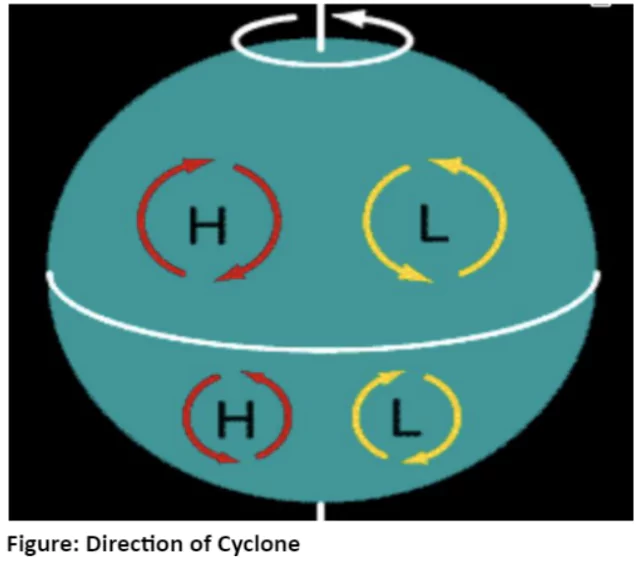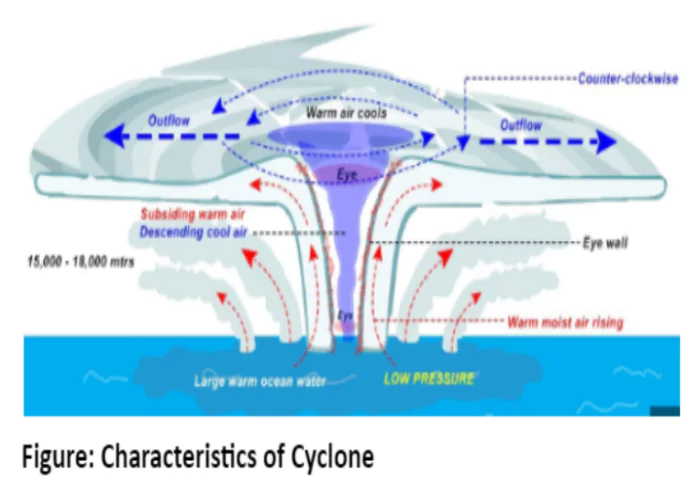![]() April 29, 2024
April 29, 2024
![]() 5087
5087
![]() 0
0
Cyclones are big, swirling masses of air rotating around a centre of low pressure. This is a powerful natural phenomenon characterized by strong winds and heavy rainfall. It is a low-pressure area in the atmosphere in which winds spiral upward. Cyclones can vary in size and strength. Understanding the formation, behaviour, and impact of cyclones is crucial for mitigating their effects and protecting vulnerable communities in their path.

| Pressure System | Pressure Condition at the Centre | Pattern of Wind Direction | |
| Northern Hemisphere | Southern Hemisphere | ||
| Cyclone | Low | Anticlockwise | Clockwise |
| Anticyclone | High | Clockwise | Anticlockwise |
 High Relative Humidities: in the lower and middle tropospheres is essential for cyclone development.
High Relative Humidities: in the lower and middle tropospheres is essential for cyclone development.| Characteristic | Tropical Cyclone | Temperate Cyclone |
| Origin | Thermal Origin | Dynamic Origin – Coriolis Force, Movement of Air Masses |
| Latitude | 10-30° N and S of the equator | 35-65° N and S of the equator. More pronounced in Northern hemisphere due to greater temperature contrast |
| Frontal System | Absent | Formation due to frontogenesis |
| Formation | Forms at sea (>26-27°C); dissipates on land | Can form on land and seas |
| Season | Seasonal: Late summers (Aug-Oct) | Irregular, fewer in summers, more in winters |
| Size | Limited to smaller area: 100-500 km diameter | Larger area: 300-2000 km diameter |
| Shape | Elliptical, Anvil Shaped | Inverted ‘V’ (middle latitude cyclones) |
| Rainfall | Heavy but short-lasting | Slow, continuous rainfall for days or weeks |
| Wind Velocity | Much greater (100-250 kmph) | Comparatively low (30-150 kmph) |
| Isobars | Complete circles, steep pressure gradient | ‘V’ shaped, low pressure gradient |
| Lifetime | Lasts <1 week | Lasts 2-3 weeks |
| Path | East to West (Trade Winds) | West to East (Weterlies) |
| Calm Region | Eye at the center, calm region with no rainfall | No single region with inactive winds or rains |
| Driving Force | Energy from latent heat of condensation | Energy depends on air mass densities |
| Influence of Jet Streams | Relationship with upper-level airflow less clear | Distinct relationship with upper-level airflow (Jet streams, Rossby waves) |
| Clouds | Few varieties (cumulonimbus, nimbostratus) | Variety of cloud development at various elevations; occluded front clouds |
| Influence on India | Affects both coasts; East coast is more impacted | Brings rains to North-West India; associated with ‘Western Disturbances’ |
| Must Read | |
| Current Affairs | Editorial Analysis |
| Upsc Notes | Upsc Blogs |
| NCERT Notes | Free Main Answer Writing |
<div class="new-fform">
</div>

Latest Comments